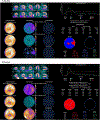Effects of cardiac rehabilitation with and without meditation on myocardial blood flow using quantitative positron emission tomography: A pilot study
- PMID: 31529385
- PMCID: PMC9178923
- DOI: 10.1007/s12350-019-01884-9
Effects of cardiac rehabilitation with and without meditation on myocardial blood flow using quantitative positron emission tomography: A pilot study
Abstract
Background: Psychosocial stress is recognized as a risk factor for coronary heart disease (CHD). High rates of CHD in African-Americans may be related to psychosocial stress. However, standard cardiac rehabilitation (CR) usually does not include a systematic stress-reduction technique. Previous studies suggest that the Transcendental Meditation (TM) technique may reduce CHD risk factors and clinical events. This pilot study explored the effects of standard CR with and without TM on a measure of CHD in African-American patients.
Methods: Fifty-six CHD patients were assigned to CR, CR + TM, TM alone, or usual care. Testing was done at baseline and after 12 weeks. The primary outcome was myocardial flow reserve (MFR) assessed by 13N-ammonia positron emission tomography (PET). Secondary outcomes were CHD risk factors. Based on guidelines for analysis of small pilot studies, data were analyzed for effect size (ES).
Results: For 37 patients who completed posttesting, there were MFR improvements in the CR + TM group (+20.7%; ES = 0.64) and the TM group alone (+12.8%; ES = 0.36). By comparison, the CR-alone and usual care groups showed modest changes (+ 5.8%; ES = 0.17 and - 10.3%; ES = - 0.31), respectively. For the combined TM group, MFR increased (+ 14%, ES = 0.56) compared to the combined non-TM group (- 2.0%, ES = - 0.08).
Conclusions: These pilot data suggest that adding the TM technique to standard cardiac rehabilitation or using TM alone may improve the myocardial flow reserve in African-American CHD patients. These results may be applied to the design of controlled clinical trials to definitively test these effects.
Trial registration: ClinicalTrials.gov registration # NCT01810029.
Keywords: Positron emission tomography; cardiac imaging; meditation; myocardial blood flow; myocardial flow reserve; stress reduction; transcendental meditation.
© 2019. American Society of Nuclear Cardiology.
Conflict of interest statement
Figures



References
-
- Balady GJ, Williams MA, Ades PA, et al. Core components of cardiac rehabilitation/secondary prevention programs: 2007 update: a scientific statement from the American Heart Association Exercise, Cardiac Rehabilitation, and Prevention Committee, the Council on Clinical Cardiology; the Councils on Cardiovascular Nursing, Epidemiology and Prevention, and Nutrition, Physical Activity, and Metabolism; and the American Association of Cardiovascular and Pulmonary Rehabilitation. Circulation. 2007;115(20):2675–82. - PubMed
-
- Mead H, Ramos C, Grantham SC. Drivers of Racial and Ethnic Disparities in Cardiac Rehabilitation Use: Patient and Provider Perspectives. Med Care Res Rev. 2016;73(3):251–82. - PubMed
-
- Midence L, Mola A, Terzic CM, et al. Ethnocultural diversity in cardiac rehabilitation. J Cardiopulm Rehabil Prev. 2014;34(6):437–44. - PubMed
-
- Anderson L, Oldridge N, Thompson DR, et al. Exercise-Based Cardiac Rehabilitation for Coronary Heart Disease: Cochrane Systematic Review and Meta-Analysis. J Am Coll Cardiol. 2016;67(1):1–12. - PubMed
-
- Rozanski A, Blumenthal JA, Davidson KW, et al.. The epidemiology, pathophysiology, and management of psychosocial risk factors in cardiac practice: the emerging field of behavioral cardiology. J Am Coll Cardiol. 2005;45(5):637–51. - PubMed
Publication types
MeSH terms
Associated data
Grants and funding
LinkOut - more resources
Full Text Sources
Medical

